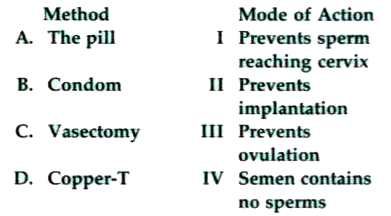Given below are four methods (A-D) and their modes of action (i-iv) in achieving contraception. Select their correct matching from the four options that follow
MethodMode of ActionA.Oral pill(i)Prevents sperms reaching cervixB.Condom(ii)Suppresses sperm motilityC.Vasectomy(iii)Prevents ovulationD.Copper T(iv)Semen contain no sperms
A-(iii),B-(iv),C-(i),D-(ii)
A-(ii),B-(iii),C-(i),D-(iv)
A-(iii),B-(i),C-(iv),D-(ii)
A-(iv),B-(i),C-(ii),D-(iii)
The correct Answer is:C
Step by step video, text & image solution for Given below are four methods (A-D) and their modes of action (i-iv) in achieving contraception. Select their correct matching from the four options that follow {:(,"Method",,"Mode of Action"),("A.","Oral pill","(i)","Prevents sperms reaching cervix"),("B.","Condom","(ii)","Suppresses sperm motility"),("C.","Vasectomy","(iii)","Prevents ovulation"),("D.","Copper T","(iv)","Semen contain no sperms"):} by Biology experts to help you in doubts & scoring excellent marks in Class 12 exams.
Topper's Solved these Questions
- BOOK - NCERT FINGERTPS ENGLISHCHAPTER - REPRODUCTIVE HEALTHEXERCISE - HOTS5videos
REPRODUCTIVE HEALTH
- BOOK - NCERT FINGERTPS ENGLISHCHAPTER - REPRODUCTIVE HEALTHEXERCISE - EXEMPLAR13videos
REPRODUCTIVE HEALTH
- BOOK - NCERT FINGERTPS ENGLISHCHAPTER - REPRODUCTION IN ORGANISMEXERCISE - All Questions137videos
REPRODUCTION IN ORGANISM
- BOOK - NCERT FINGERTPS ENGLISHCHAPTER - SEXUAL REPRODUCTION IN FLOWERING PLANTSEXERCISE - Sexual Reproduction In Flowering Plants145videos
SEXUAL REPRODUCTION IN FLOWERING PLANTS
Similar Questions
Given below ar four methods (a-d) and their modes of action (i-iv) in achieving contraception. Select their correct mathing from the four options that follow.
MethodMode of Action(a) The pill (i) Prevents sperms reaching cervix(b) Condom(ii) Prevents implantation(c) Vasectomy(iii) Prevents ovulation(d) Copper-T(iv) Semen contains no spermView SolutionGiven below are four methods and their mode of action in achieving contraception. Find the incorrect match.
View Solution
Knowledge Check
- Question 1 - Select One
Match the following with reference to cockroach and choose the correct option
A.Phallomere(i)Chain of developing ovaB.Gonopore(ii)Bundles of spermC.Spermatophore(iii)Opening of the ejacultory ductD.Ovarioles(iv)The external genitaliaAABCD3421BABCD4321CABCD4231DABCD2431 - Question 2 - Select One
Match column I with column II and select the correct option form the codes given below.
Column IColumn IIA.Factor II(i)ThromboplastinB.Factor III(ii)ProthrombinC.Factor VIII(iii)Hageman factorD.Factor XII(iv)Antihaemophilic globulinAA-(iii),B-(iv),C-(ii),D-(i)BA-(iv),B-(iii),C-(ii),D-(i)CA-(ii),B-(i),C-(iv),D-(iii)DA-(i),B-(ii),C-(iii),D-(iv) - Question 3 - Select One
Match column I with column II and select the correct option from the codes given below.
Column IColumn IIA.RBC(i)CoagulationB.Antibody(ii)ImmunityC.Platelets(iii)ContractionD.Systole(iv)Gas transpot(v)HypertensionAA-(v),B-(i),C-(iv),D-(iii)BA-(ii),B-(iv),C-(iii),D-(i)CA-(iv),B-(ii),C-(i),D-(iii)DA-(iii),B-(v),C-(ii),D-(iv)
Given below are the four methods (A – D) and their modes of achieving contraception . Select suitable match from the options given below :
 View Solution
View SolutionMultiple choice questions (MCQs)
choose the correct option
Given below are four methods (A-D) and their modes of action (a-d) in achieving contraception. Select their correct matching from the four options that follow
 View Solution
View SolutionMatch the following with reference to cockroach and choose the correct option
A.Phallomere(i)Chain of developing ovaB.Gonopore(ii)Bundles of spermC.Spermatophore(iii)Opening of the ejacultory ductD.Ovarioles(iv)The external genitaliaView SolutionMatch column I with column II and select the correct option from the codes given below
Column IColumn IIA.Choanocytes(i)PlatyhelminthesB.Chindoblasts(ii)CtenophoraC.Flame cells(iii)PoriferaD.Nephridia(iv)CoelenterataE.Comb plates(v)AnnelidaView SolutionMatch column I with column II and select the correct option from the codes given below.
Column IColumn IIA.Rhizopus(i)AscomycetesB.Penicillium(ii)BasidiomycetesC.Ustilago(iii)DeuteromycetesD.Alternaria(iv)PhycomycetesView Solution

